AUBIO 230: Topic 3 (Membrane Structure in Eukaryotes)
1/74
There's no tags or description
Looks like no tags are added yet.
Name | Mastery | Learn | Test | Matching | Spaced |
|---|
No study sessions yet.
75 Terms
plasma membrane (function)
all living things possess it
-separates and protects the internal contents from the external environments
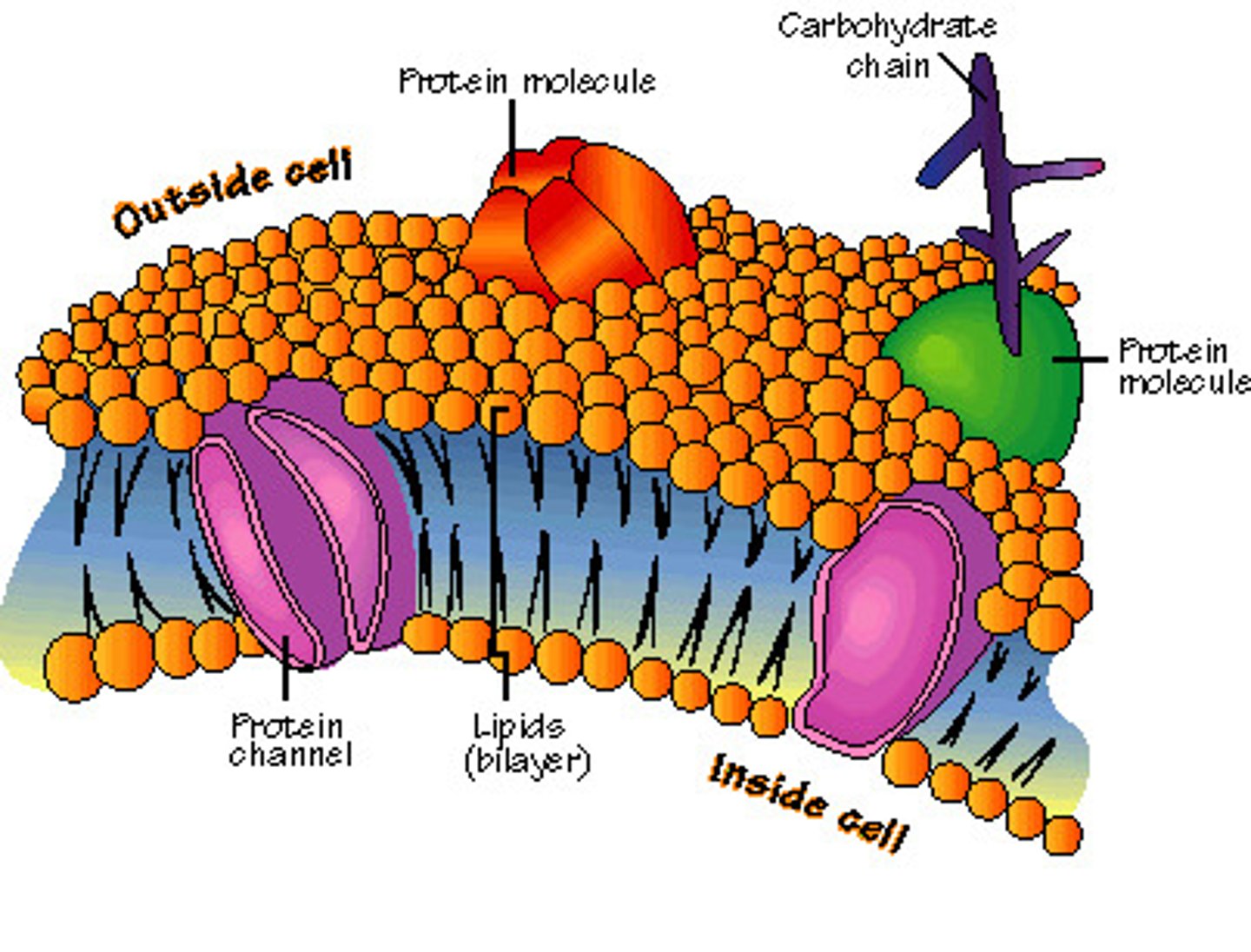
plasma membrane (structure)
made up of 2 sheets of lipid molecules embedded with proteins
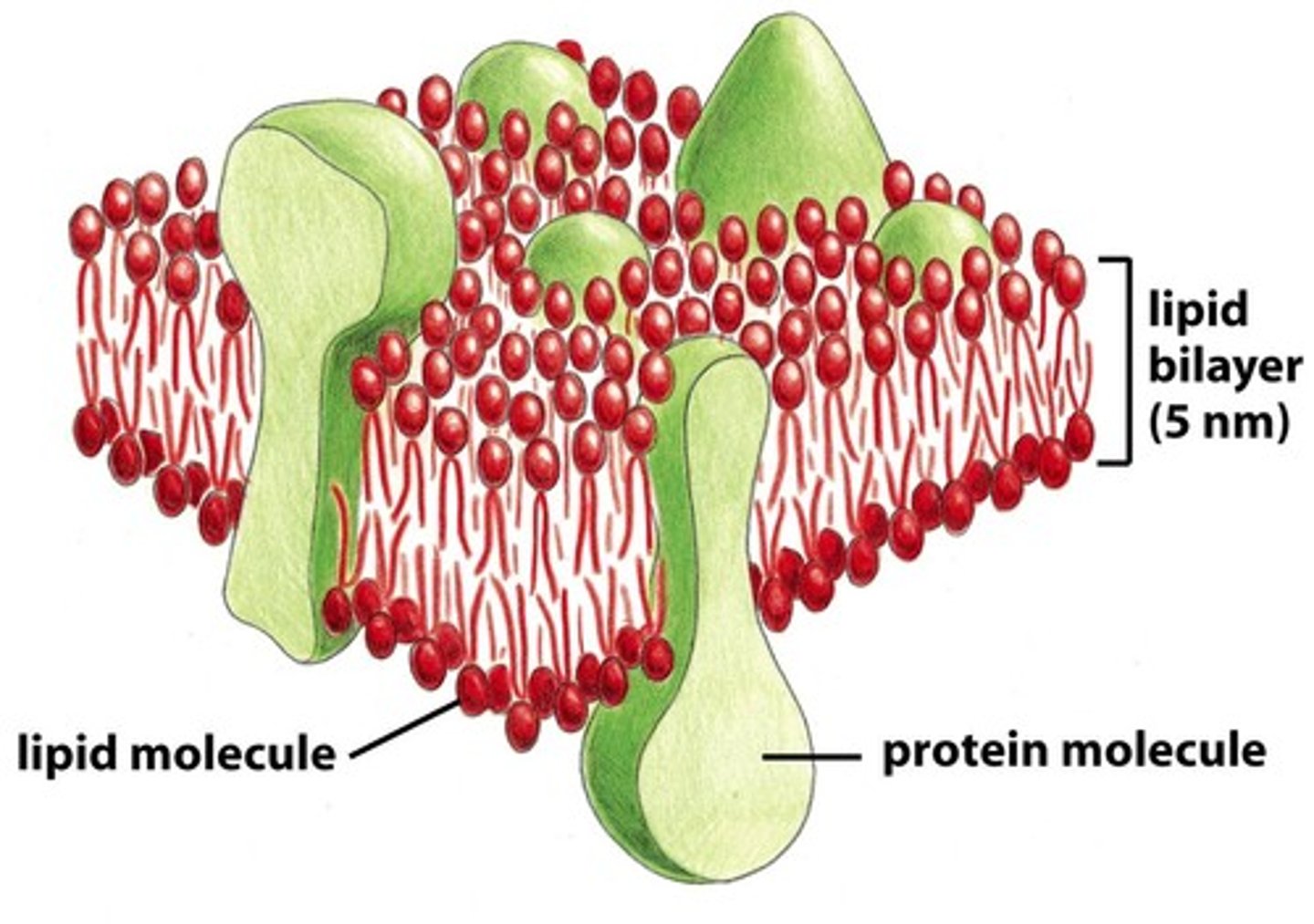
what is the only membrane prokaryotic cells have?
plasma membrane
What are the 2 membranes of eukaryotic cells?-
-plasma membrane (external membrane)
-internal membranes
internal membranes
-enclose various organelles & differ slightly from the plasma membrane in composition
regardless of the location of a membrane in a cell, what is common between them
all membranes of a cell share a common structure
Explain the common structure of all membranes
-lipid bilayer: 2 layers of lipids in opposite directions & gives selective permeability to PM & confers the permeability feature to other organelles
-proteins: unique characteristics & functions determined by the kind of protein contained within it
selective permeability
A property of a plasma membrane that allows some substances to cross more easily than others.
functions of all membranes (5)
1. define boundaries, permeability barriers determining what goes in & out.
2. sites for specific biochemical functions.
3. regulate in & out movement of substances using protein transport
4. detection & transmission of electrical & chemical signals
5. cell-cell adhesion & communication mediated by membrane proteins
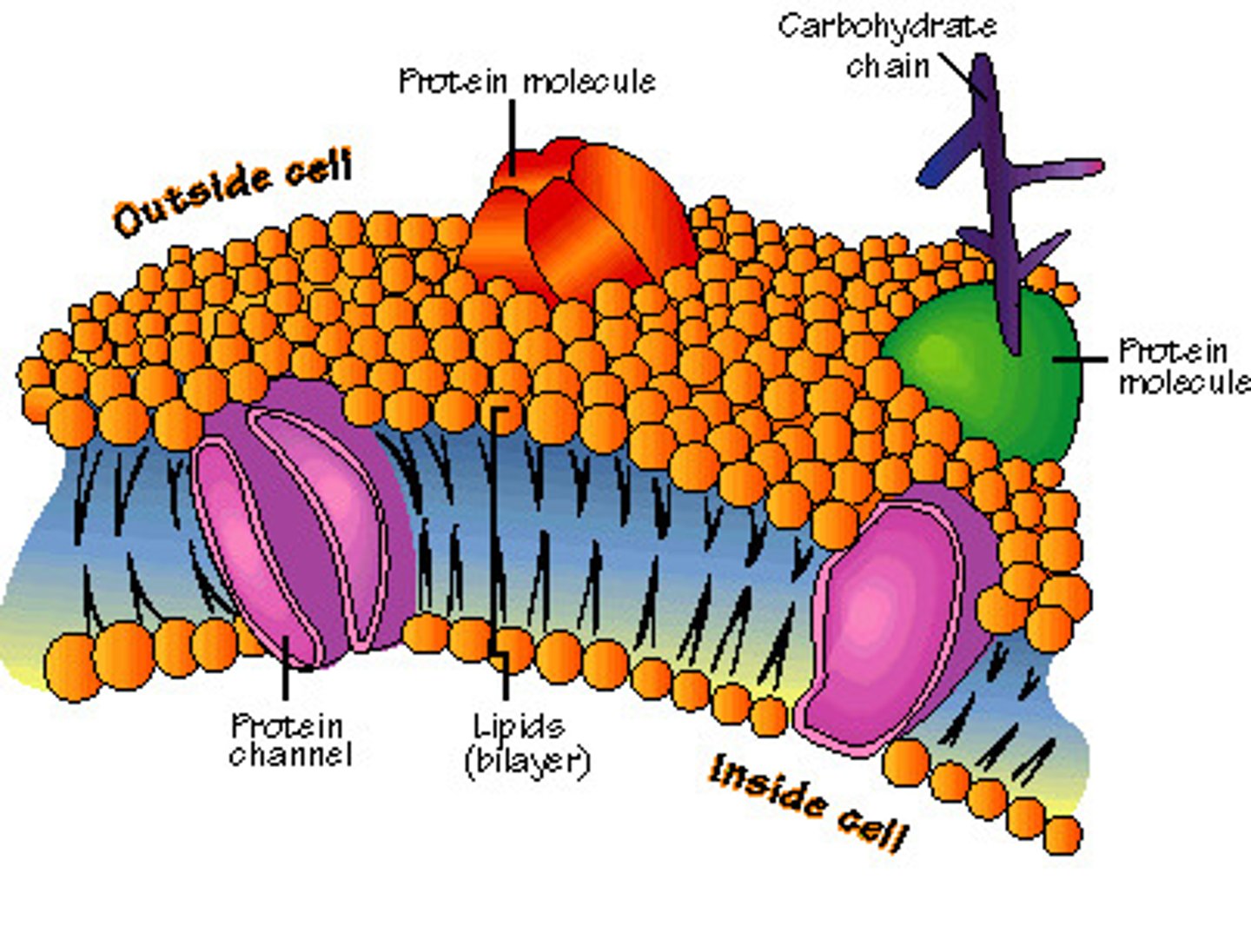
explain the 1st function of membranes (define boundaries, permeability barriers determining what goes in & out.)
plasma membrane serves as barrier for entire cell. Internal membranes ensure compartmentalization of functions
Define the 2nd function of membranes
due to their proteins characterized by type of proteins embedded in them. diff organelle shave distinct membrane proteins to perform specialized roles)
explain the 4th function of membranes (detection & transmission of electrical & chemical signals)
in plasma membrane there are receptor proteins that detect signals from the outside and rely the signals inside the cell
function of membranes example (mitochondria)
mitochondrial inner membrane: electron transport chain involved in ATP production via oxidative phosphorylation
function of membranes example (golgi apparatus membrane)
glycosylation enzymes add sugars to proteins, vesicle-targeting proteins will do protein modification & sorting
lipid bilayer
-cells are filled with water internally (cytosol) & surrounded by it externally
-lipids are hydrophobic, so water presence influences behavior of lipids
-determines structure of cell membranes b/c composed of mostly lipids
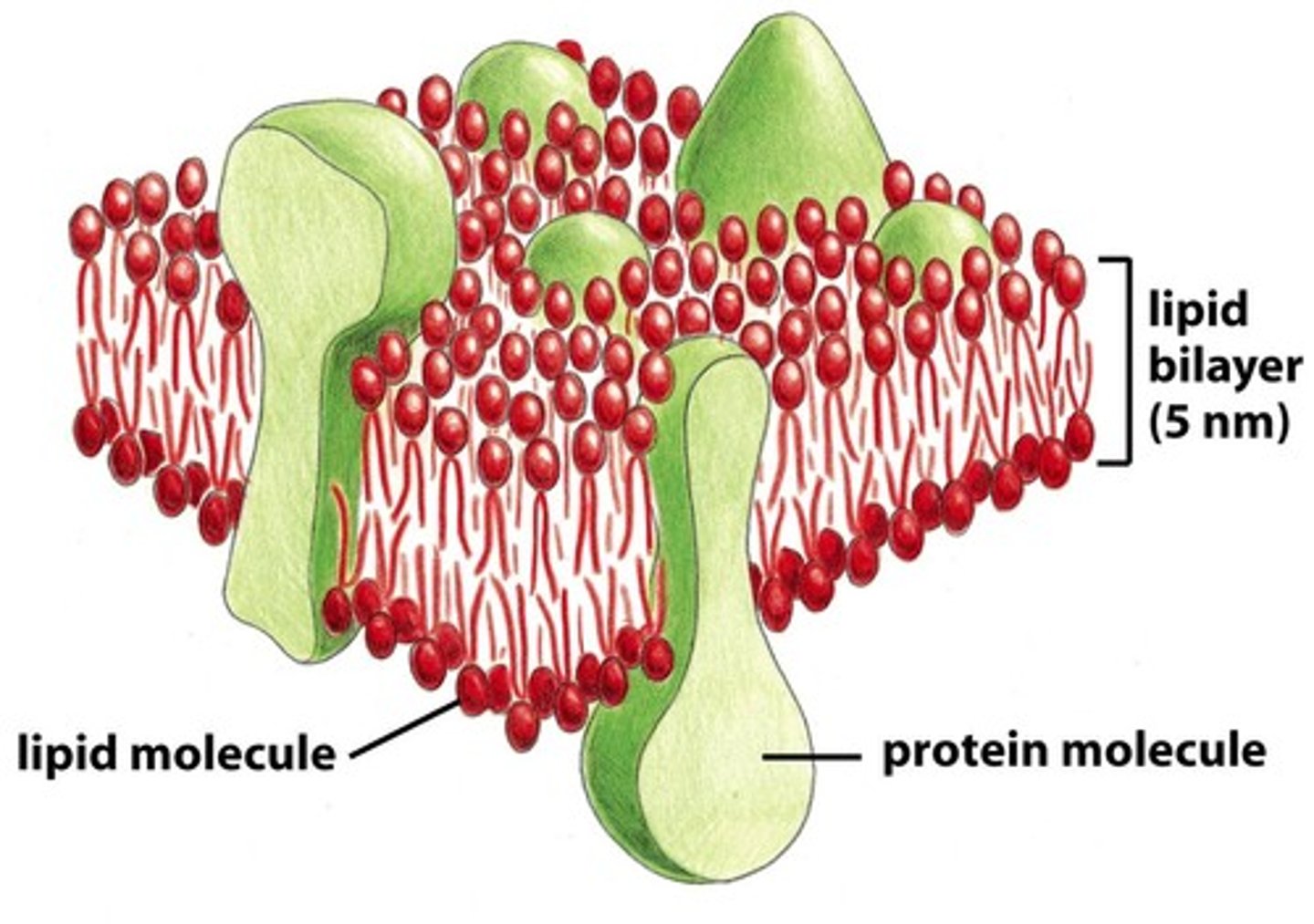
hydrophilic molecules
-charged molecules that are attracted to the partial charge of the water molecule
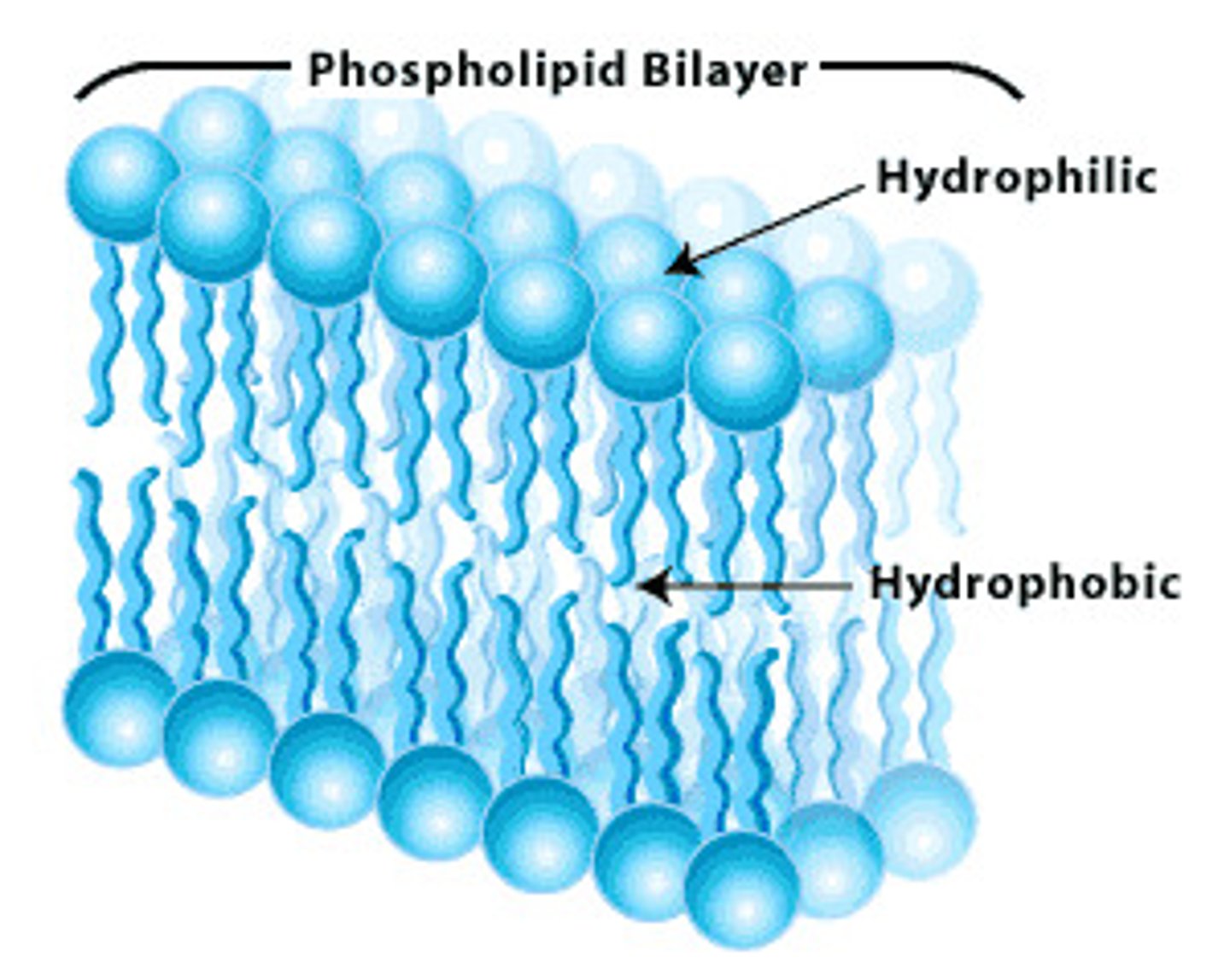
hydrophobic molecules
-uncharged & repel water
-tend to aggregate together
What property do most membrane lipids have
they are amphipathic
amphipathic (in terms of lipid)
-have hydrophilic component AND
-hydrophobic component
(1 component drawn to water and the other component repels water)
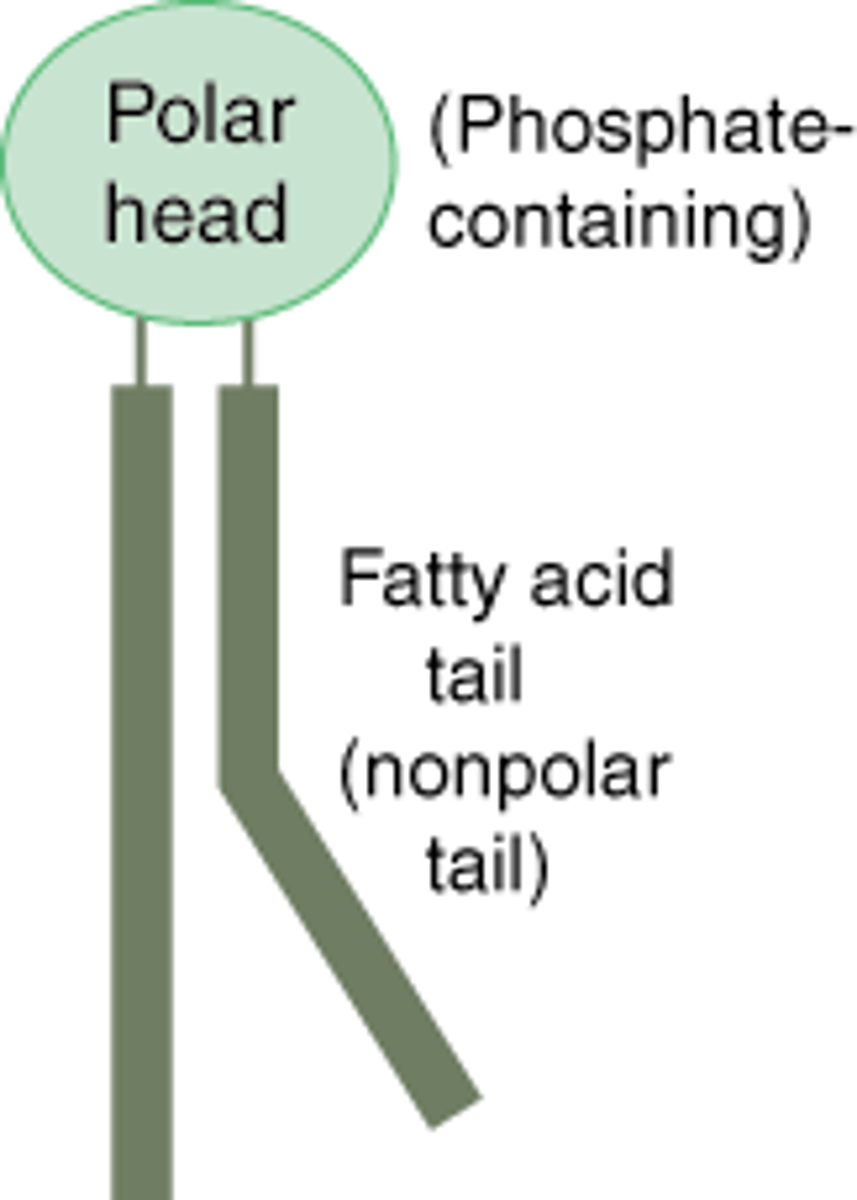
hydrophilic component
-loves water,
-lipid head
-contains charged, partially charged, or polar group)
hydrophobic component
-hates water
-lipid tail
-contains mostly C & H
What does the amphipathic nature of lipids cause?
makes the lipids to form bilayer in aqueous environments
-heads face water, tails associate together moving away from water.
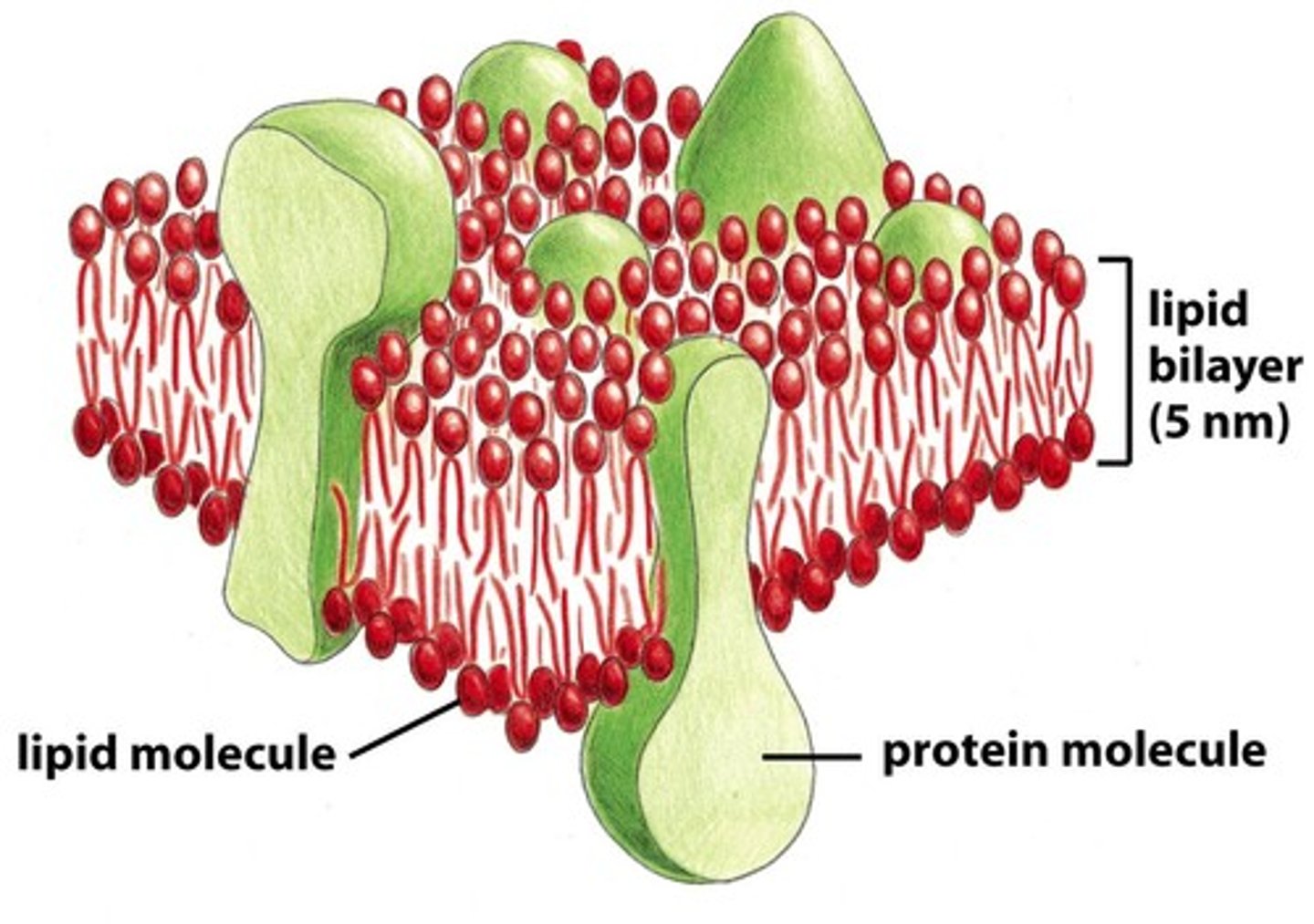
what substance primarily determines the behavior of lipid bilayers?
water
properties of lipid bilayer
-flexibility
-fluid
flexibility (property of lipid bilayer)
ability to bend, flexion motion
Describe the flexibility of lipid bilayers
-they spontaneously fold inwards which is Energetically favourable (eventually form a ball to shield the hydrophobic side
-spontaneous rearrangement to exclude water molecules
-eliminates free edges (hydrophilic side exposed to water)
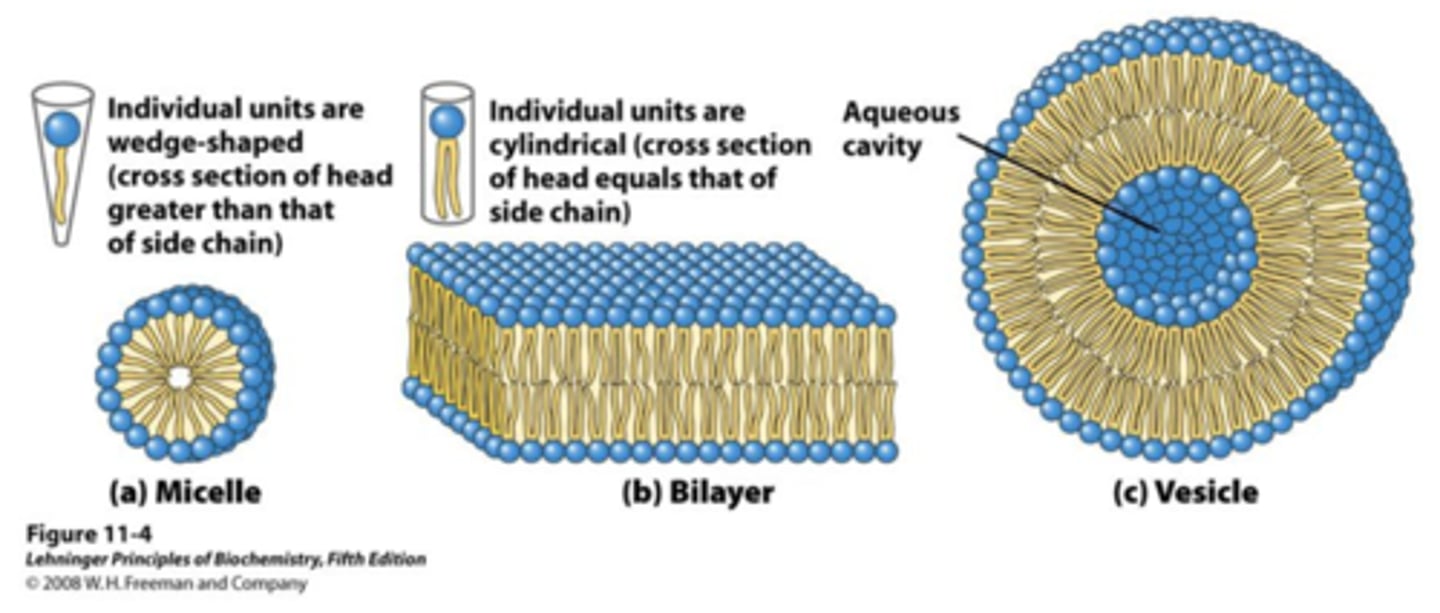
What does lipid bilayers flexibility help them to form?
-closed vesicles or compartments (ring structure)
-is energetically favorable
-makes membranes self-sealing (self-repair)
fluidity (property of lipid bilayer)
-movement of lipid molecules freely w/i membranes (but cannot escape from bilayer b/c forces holding them together)
3 different types of motions by exhibited lipids within the lipid bilayer do the fluidity property
-flip-flops/transverse diffusion
-lateral diffusion
-rotation
flip-flops/transverse diffusion motion
-lipid molecules crossing to other side of membrane
-energetically unfavorable
-rare
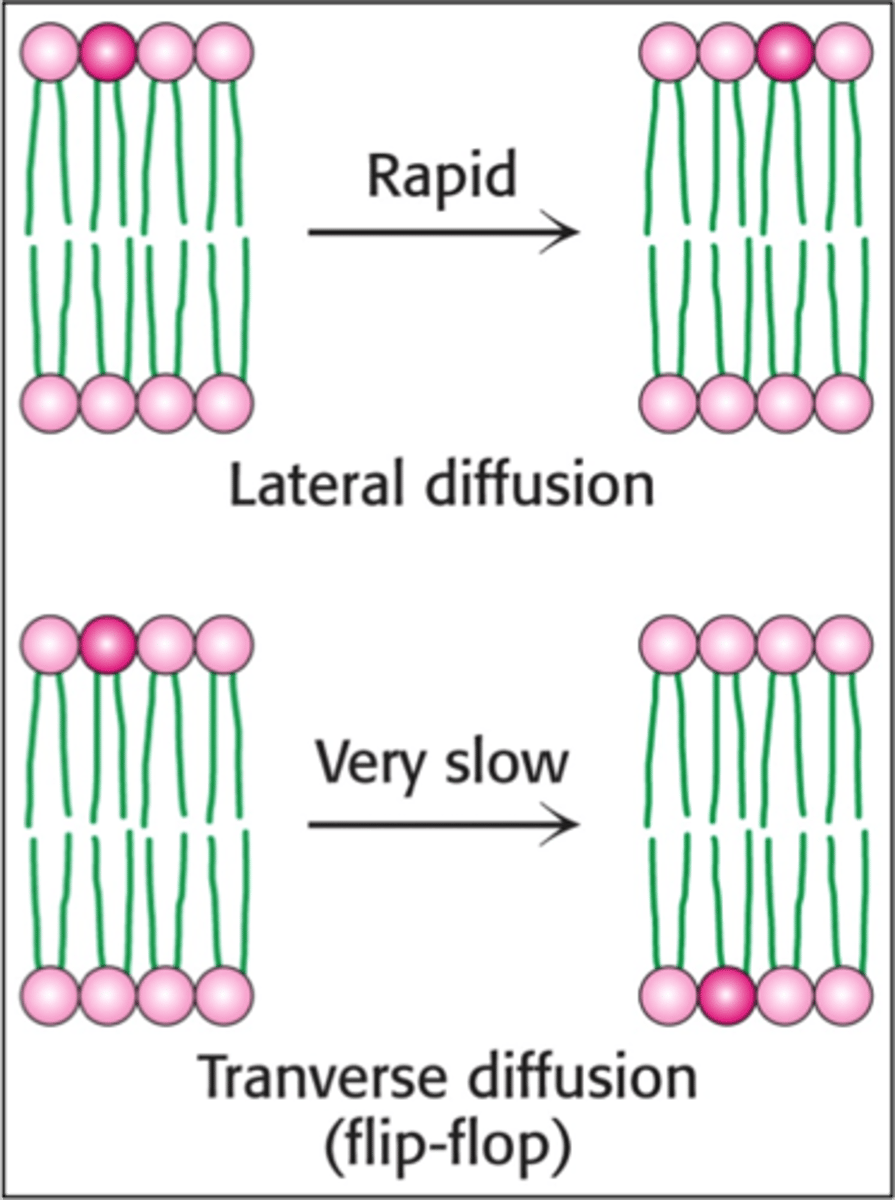
lateral diffusion motion
-exchanging places w neighbours (adjacent) within same monolayer
-occurs rapidly
rotation motion
-rotatory movement of single lipid molecule around their longitudinal axis
-occurs rapidly
What are the factors that affect fluidity of the membrane
1. temperature
2. lipid composition
3. degree of unsaturation
4. cholesterol content
How does temperature affect membrane fluidity
-high temp. increases molecular movement & membrane fluidity (movement of molecules enhanced by thermal E)
-lower temp --> thermal E & movement reduces
How does lipid composition affect membrane fluidity
-shorter hydrocarbon chain length increases fluidity (room for more free movement)
-longer HC chain reduced fluidity because the more HCs, the more tightly packed they are, reducing free movement
unsaturated
double bonds
How does degree of unsaturation affect membrane fluidity
-unsaturated fatty acids increase fluidity due to kinks of double bonds which prevent tight packing (more free movement)
cholesterol
-kind of lipid belonging to steroid category & amphipathic with polar head and nonpolar tail
How does cholesterol content affect membrane fluidity
-present in euk animal plasma membranes
-fills up spaces created by kinks b/w adjacent, unsaturated lipid molecules
-stiffens the bilayer, reducing fluidity, flexibility, and permeability
Where does membrane assembly start?
in the endoplasmic reticulum (b/c ER manufactures most cell components)
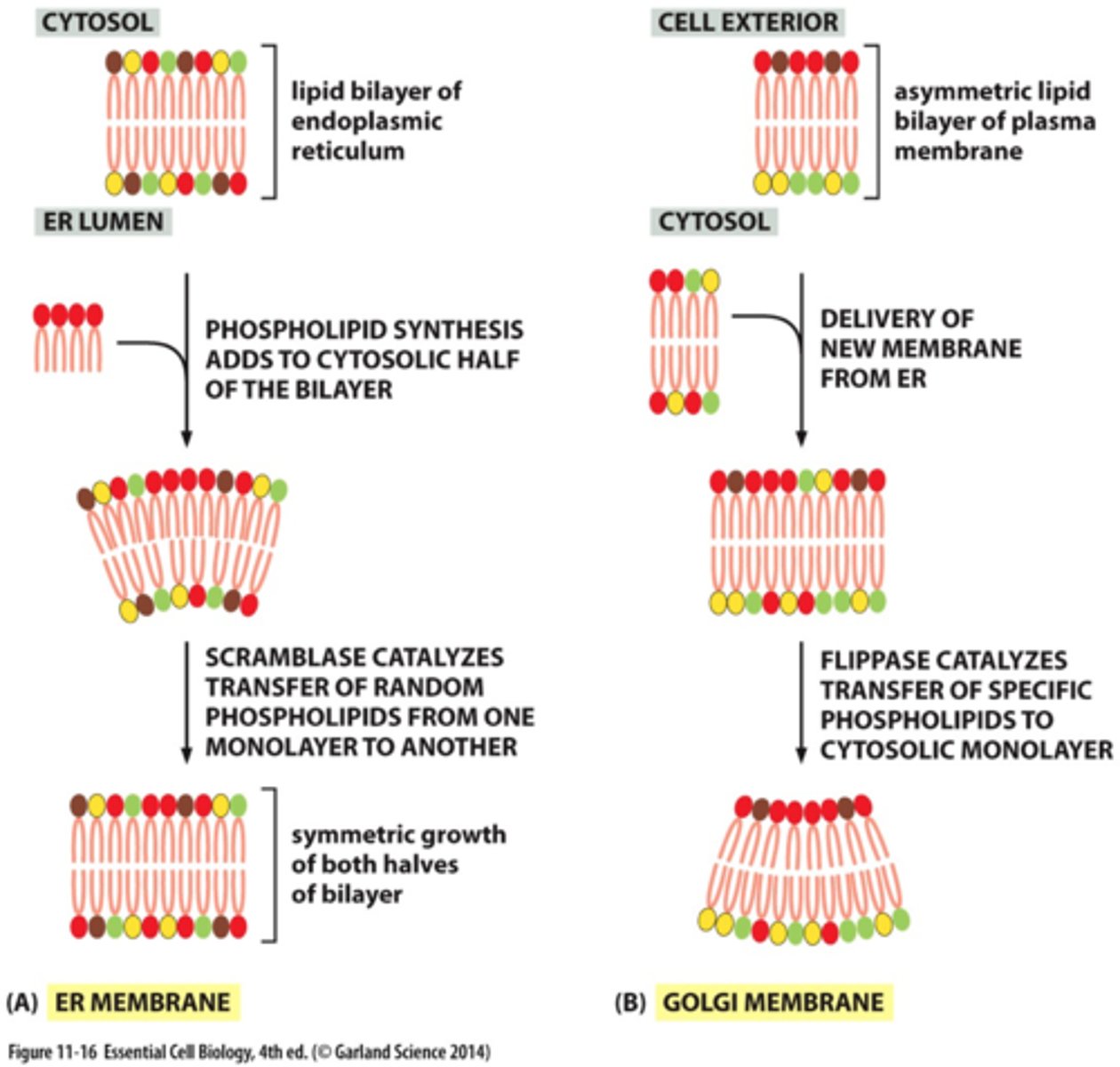
How is the membrane assembled in the ER
on ER membrane there are biosynthetic enzymes that synthesize new phospholipids used to form new membranes from fatty acids available in the cell

Steps of membrane assembly once phospholipids are synthesized in the ER
1. synthesis of phospholipids by ER biosynthetic enzymes
2. phospholipids added to cytosolic half of the bilayer
3. scramblases enzymes catalyze transfer of random phospholipids from 1 monolayer to another
4. both halves of bilayer grow symmetrically
5. membrane leaves the ER to plasma membrane or Golgi apparatus which is then transferred to final destination, some remain in ER

cytosolic half
side that is facing the cytoplasm
noncytosolic half
side facing inward towards organelle (extracellular space)
What occurs in the Golgi apparatus or other cell membranes in membrane assembly
1. membrane delivered from ER to GA or other membranes to Non cytosolic side (golgi lumen)
2. flippase catalyzes transfer of specific phospholipids to cytosolic monolayer
3. creates asymmetric distribution of phospholipids.
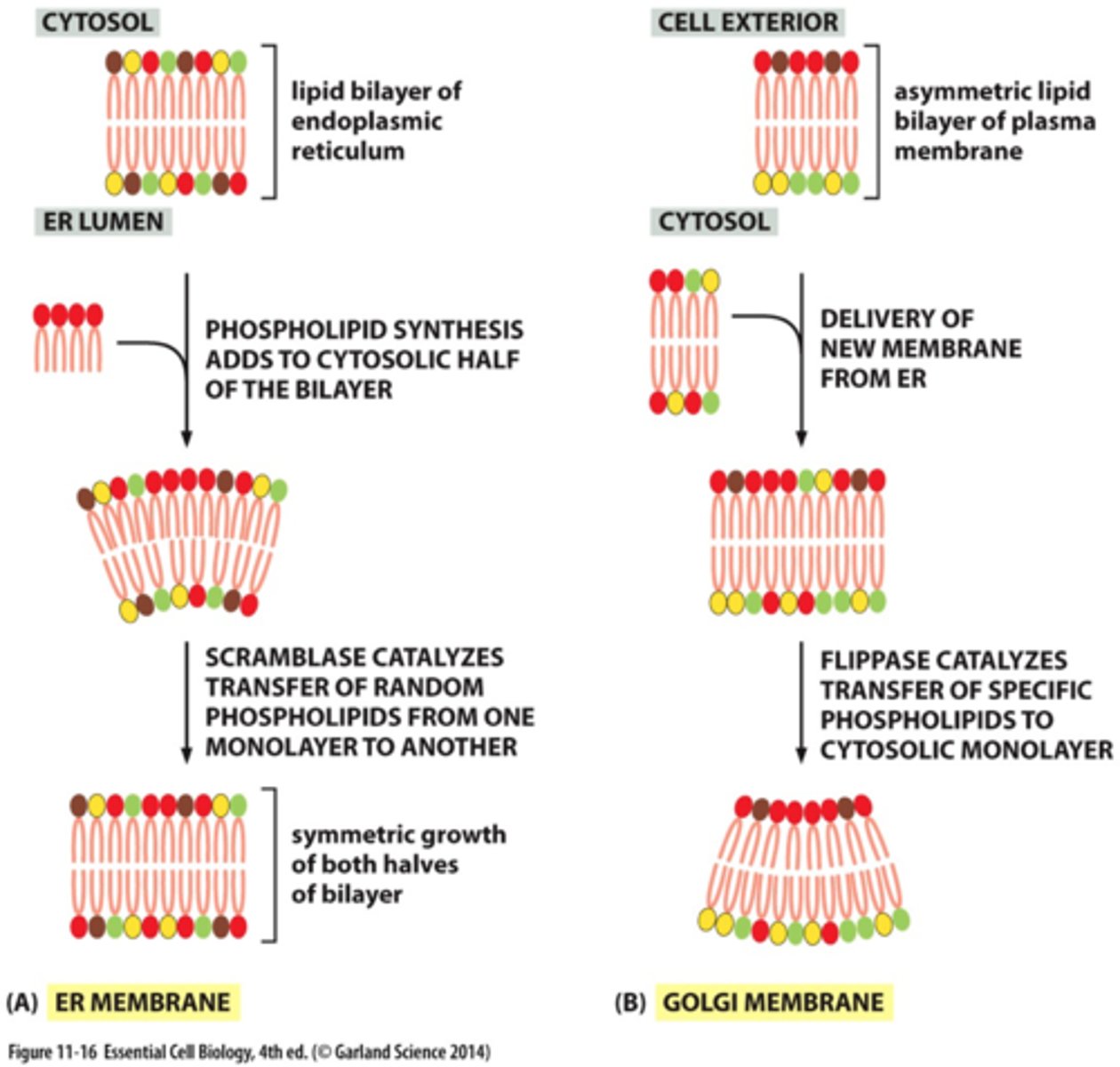
glogi lumen
noncytosolic side
Important factors about asymmetry in membrane
-asymmetry is preserved as membranes move between compartments -cell membranes maintain distinct inside & outside faces (stays in noncytosolic or cytosolic path as travels)
things found in membranes besides phospholipids
-proteins
-lipids
-carbohydrates
membrane proteins
proteins are embedded in membranes and help membranes to perform distinct functions
types of proteins
-transporters & channels (facilitates movement in or out of cell)
-anchors (things are suspended on them)
-receptors (receive signals from outside and transmit to inside the cell)
-enzymes (catalyze reactions)
What occurs when proteins are embedded in the membrane?
they interact with the lipid bilayer in various ways
In terms of the way proteins interact with the lipid bilayer, what are the 2 categories membrane proteins are split into?
- integral membrane proteins
- peripheral membrane proteins
integral membrane proteins define
integrates more deeply into membrane
peripheral membrane proteins define
attached on side of proteins
list the integral membrane protein groups
-transmembrane
-monolayer-associated
-lipid-linked
list the peripheral membrane protein groups
protein-attached
transmembrane (integral membrane proteins)
-embedded across the entire length of bilayer
-amphipathic (hydrophobic part interacts with lipid tails, hydrophilic part with aq. environment)
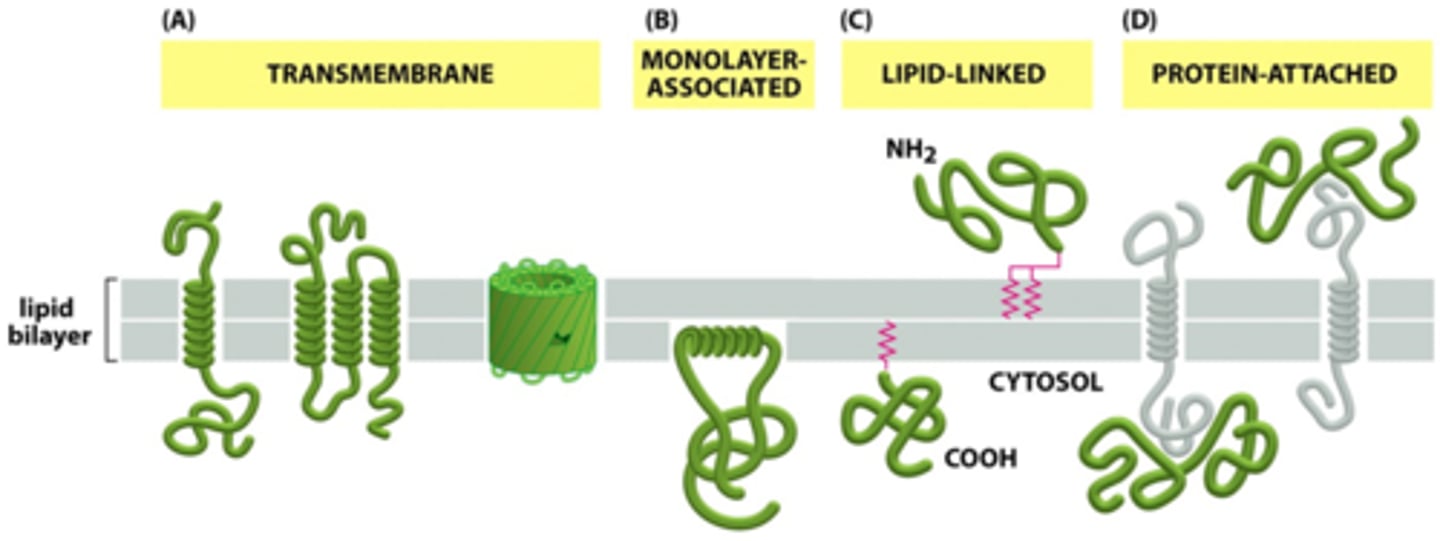
monolayer-associated (integral membrane proteins)
-associated with half of the bilayer
-almost entirely within cytosol
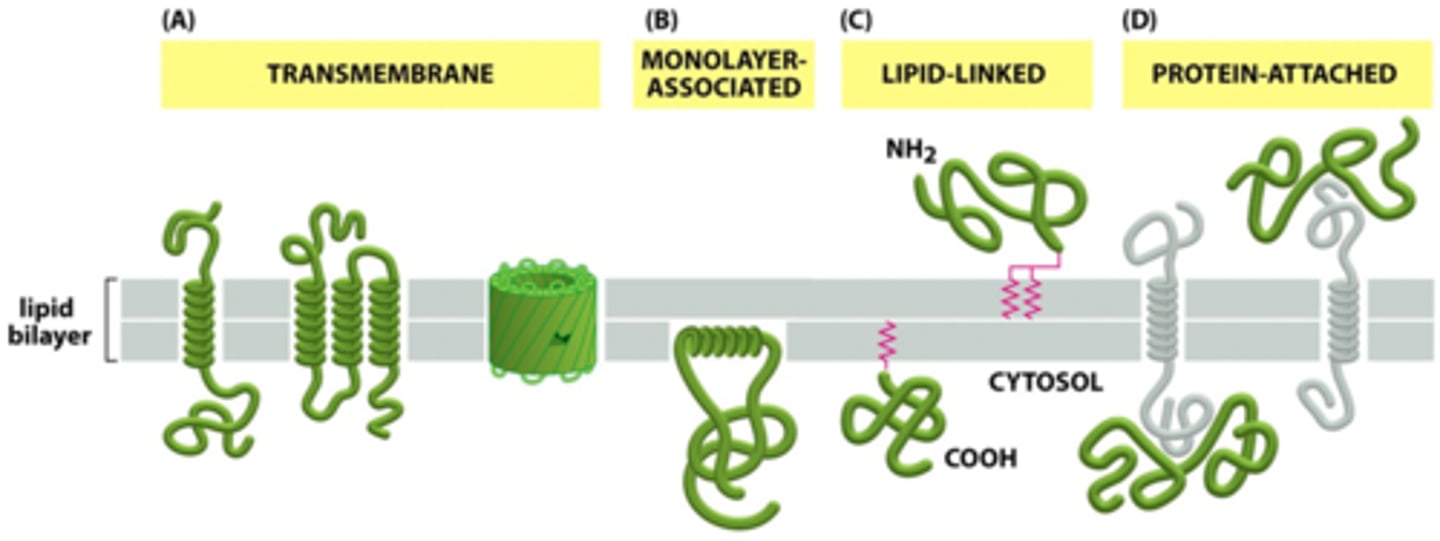
lipid linked (integral membrane proteins)
-attached outside the bilayer on either side through lipid groups (not directly attached to bilayer)
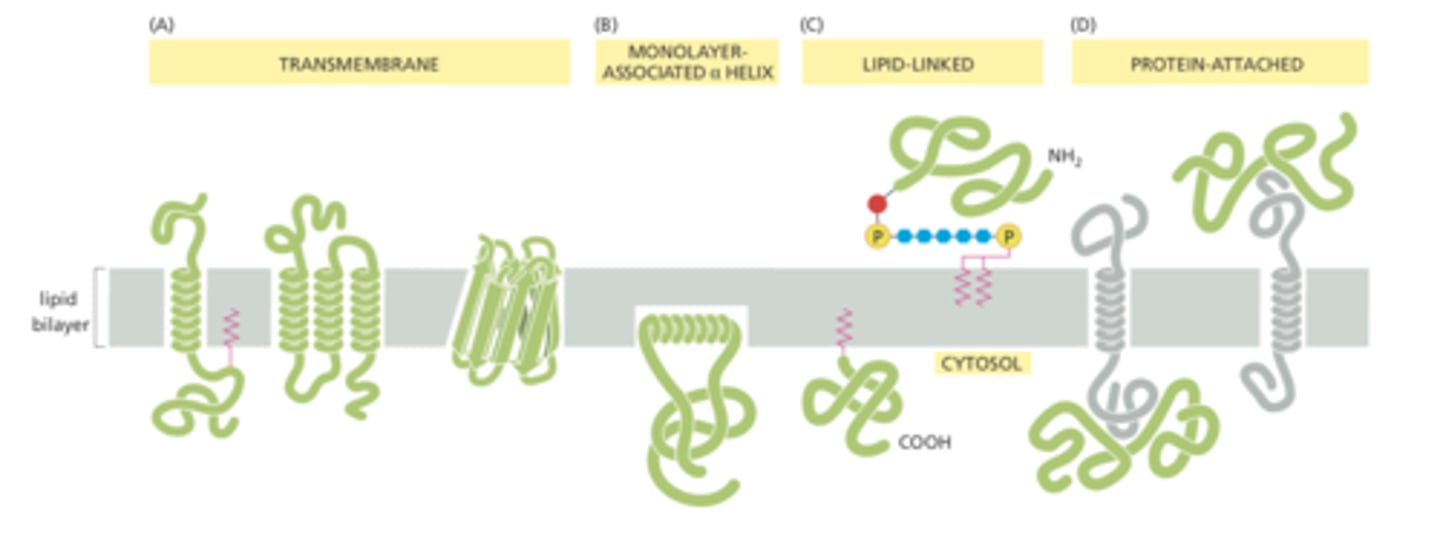
peripheral membrane protein
-protein attached, bound indirectly to either side of the membrane via interactions with other membrane proteins (not directly connected to membrane)
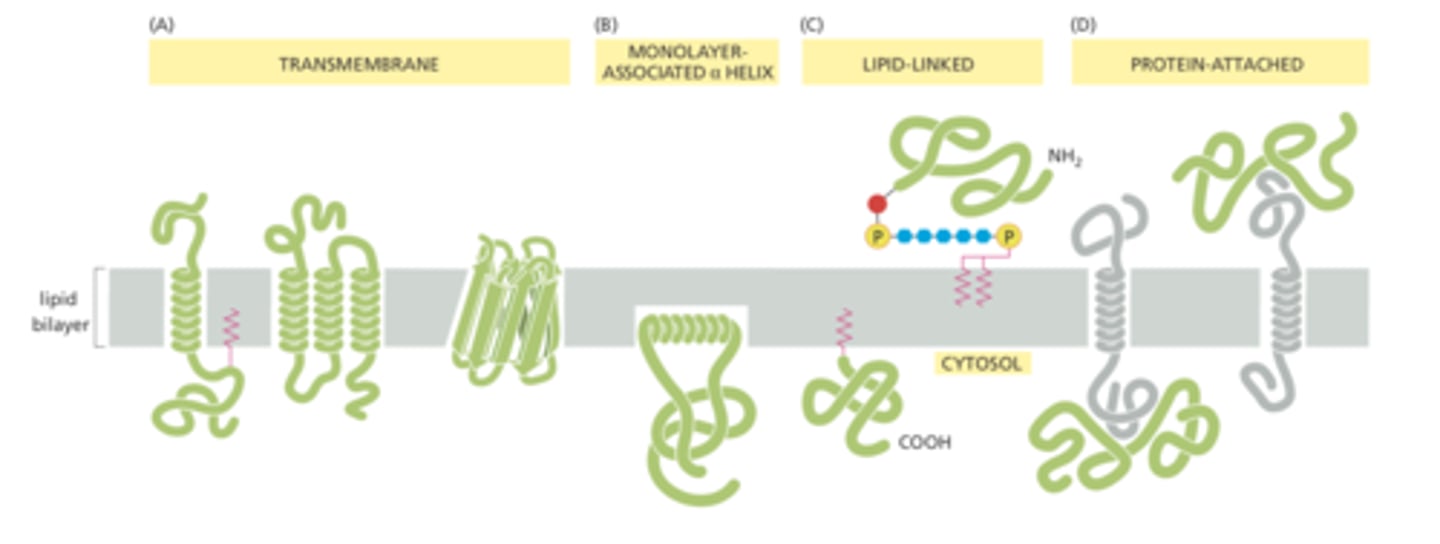
important features of polypeptide chains when crossing bilayer
-polypeptide chains cross the lipid bilayer as alpha helices (2ndary structure)
-this is the most common way of which they cross the membrane
-core of polypeptide is carrying partial +ve & -ve charges allowing to form H bond with e/o
-the backbone of a polypeptide is hydrophilic
how does a transmembrane polypeptide chain interact with the bilayer
-hydrophobic side chains face outward to interact with lipid tails
-hydrophilic backbone stays within the helix trough
(a transmembrane polypeptide chain usually crosses the lipid bilayer as an alpha helix)

Because of multiple amphipathic alpha helices, what is formed?
multiple helices can form a hydrophilic pore that is an aqueous channel across the lipid bilayer
properties of membrane proteins
-can be solubilized by detergents
can be solubilized by detergents (property of membrane proteins)
-detergents are similar to lipids in their structure by being amphipathic, but with a single tail
detergent
-SDS: ionic head (hydrophobic) or triton x with polar head
and hydrophobic tail.
detergent function
-useful for purifying & extracting membrane proteins or genomic dna
-have hydrophilic head & hydrophobic tail
-dissolve the membrane to be able to extract proteins
how is the plasma membrane strengthened (because it is thin and fragile)
reinforced by a network of specialize proteins called the cell cortex, attached beneath it
how can proteins move within the bilayer
-proteins can move freely within the lipid bilayer (just like lipids)
-however, their movement can be restricted to membrane domains
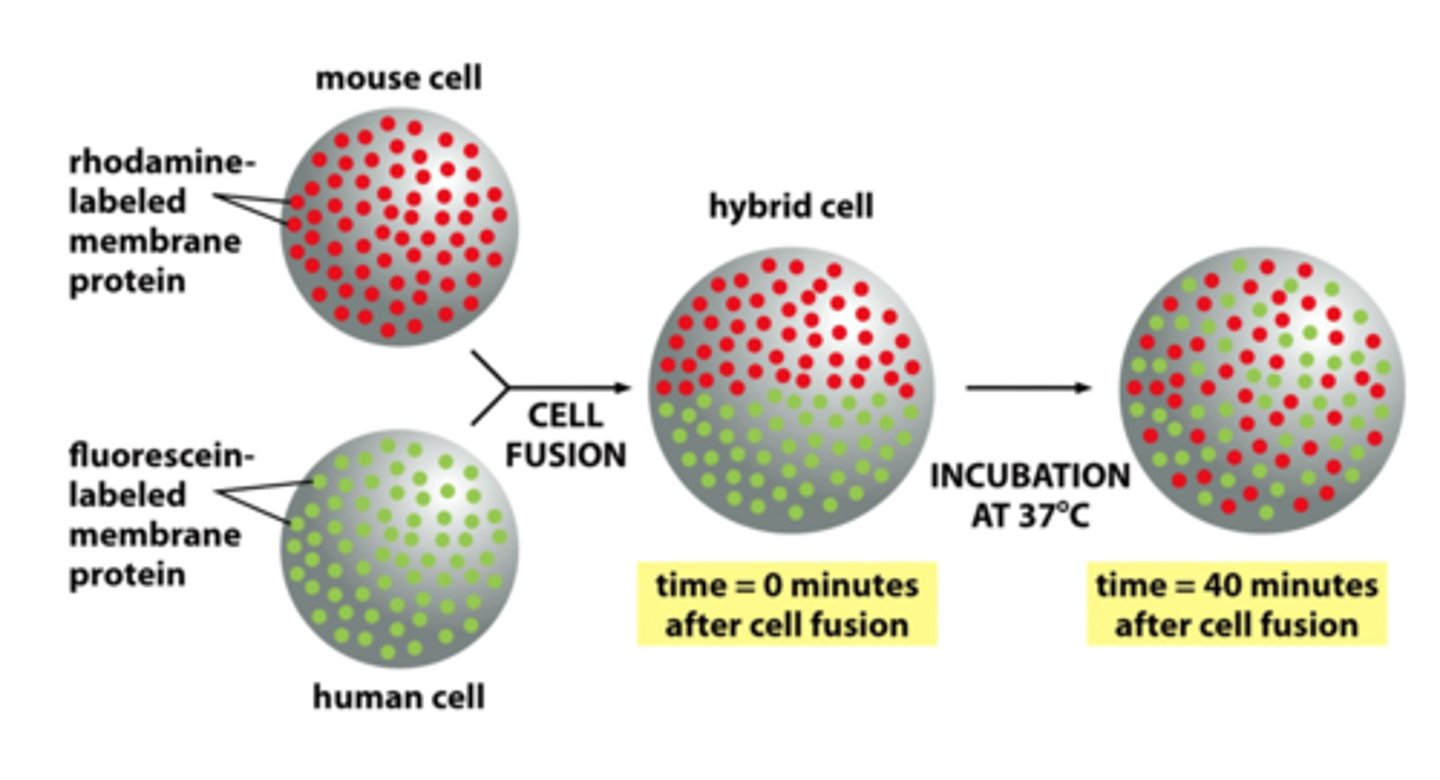
4 cases in which protein movement is restricted to membrane domains
-can be joined to cell cortex on inside of cell
-can be joined to extracellular matrix
-can be attached to proteins on surface of another cell
-diffusion barriers restrict proteins to certain membrane domain
what is the cell surface coated with
carbohydrates
different types of carbohydrates in membranes
-transmembrane glycoprotein (across entire bilayer)
-transmembrane proteoglycan (across entire bilayer)
-glycolipid
-adsorbed glycoprotein
glycoprotein
lesser carbohydrate content
proteoglycan
higher carbohydrate content
functions of cell-associated carbohydrates
-protects cell from mechanical damage
-lubrication: helps cells squeeze through narrow spaces
-cell-cell recognition & adhesion